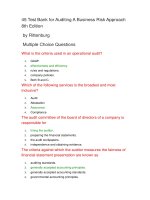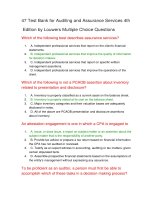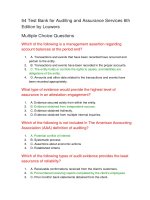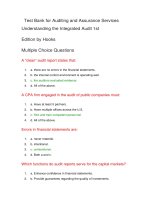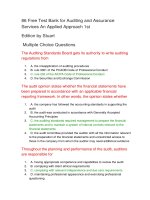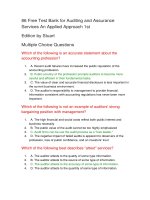Test bank for auditing and assurance a business risk approach 3rd edition
Bạn đang xem bản rút gọn của tài liệu. Xem và tải ngay bản đầy đủ của tài liệu tại đây (157.77 KB, 23 trang )
Test Bank for Auditing and Assurance A Business Risk
Approach 3rd Edition
The need for assurance services arises for all of the following reasons
except:
1. a. potential bias in providing information
2. b. closeness between a user and the organisation
3. c. complexity of the processing systems
4. d. remoteness between a user and the organisation
Independent professional services that are provided on financial or other
information that improve the quality of decision making are known as:
1. a. internal auditing
2. b. financial auditing
3. c. assurance services
4. d. attestation services
Which one of the following is not a critical component of assurance
services?
1. a. a process on which service is provided
2. b. an assurance service provider
3. c. a user who derives value
4. d. a registered company auditor
Which one of the following is not a key attribute needed to perform
assurance?
1. a. subject matter knowledge
2. b. independence
3. c. established criteria or standards
4. d. accounting skills
A service that does not always require that a report is provided to a third
party is:
1. a. assurance
2. b. attestation
3. c. audit
4. d. all of these choices
Which one of the following is not part of the attest process?
1. a. gathering evidence about assertions
2. b. proving the accuracy of the books and records
3. c. evaluating evidence against objective criteria
4. d. communicating the conclusions reached
Which of the following is/are not part of the attest process?
1. a. communicating the conclusions reached to a third party
2. b. guaranteeing the accuracy of the books and records
3. c. evaluating evidence against objective criteria
4. d. all of these choices
Which one of the following is a potential problem with management’s
communication of financial information that causes third parties to desire the
independent auditor’s assessment of the financial statement
presentation?
1. a. complexity of transactions affecting the financial statements
2. b. lack of criteria on which to base information
3. c. remoteness of the trading partner from the organisation
4. d. none of these choices
Users of the audit report can reasonably expect the audited financial
statements to be:
1. a. complete, contain all necessary information and contain all financial
disclosures
2. b. a true and fair view of the organisation’s financial results
3. c. free from all errors
4. d. all of these choices
Which one of the following is not a management expectation for independent
auditors?
1. a. an outside source of expertise on accounting matters
2. b. individuals who perform tests and draw conclusions on assertions
3. c. a participant in management decision making
4. d. a provider of a written communication
Users can reasonably expect audited financial statements to be:
1. a. complete and contain all important financial disclosures, be free from
material misstatements and be presented fairly
2. b. complete and contain all important financial disclosures, be free from
material misstatements and be presented fairly according to accounting
standards
3. c. complete, be accurate and be presented fairly according to generally
accepted accounting principles (GAAP)
4. d. complete and contain all important financial disclosures, be free from all
misstatements and be presented fairly according to the substance of
generally accepted accounting principles
Internal auditors may perform all of the following types of audits except:
1. a. operational audits
2. b. compliance audits
3. c. computer system audits
4. d. all of these choices
An ‘integrated audit’ includes an audit of:
1. a. the company’s external controls
2. b. the company’s financial statements
3. c. the company’s compliance with its rules and policies
4. d. none of these choices
Which of the following services is the broadest and most inclusive?
1. a. audit
2. b. attestation
3. c. assurance
4. d. compliance
An expectation of the public is that the auditor will recognise that the primary
users of audit assurance are:
1. a. the clients
2. b. the Public Company Accounting Oversight Board (PCAOB)
3. c. members of management
4. d. third-party users
Auditing is important in a free market society because:
1. a. the public requires auditors to function as divisions of regulatory bodies
2. b. auditors detect all errors and fraud made by company employees
3. c. it provides reliable information based upon which to judge economic
performance
4. d. the auditor is an amiable insurance policy for investors
5. e. all of these choices
Third-party users of the audit report expect the auditor to do all of the
following except:
1. a. to evaluate measurements and disclosures made by management
2. b. to provide a biased evaluation of the financial statements
3. c. to determine whether financial statements are presented in accordance
with accounting standards
4. d. to gather sufficient evidence to support their opinion
Public accounting firms performing financial report audits for companies
must:
1. a. register with the Auditing and Assurance Standards Board (AUASB)
2. b. register with the Institute of Internal Auditors
3. c. register with the Australian Securities Exchange (ASX)
4. d. have a registered company auditor sign the audit report
The auditor of financial statements must make very difficult interpretations
regarding authoritative literature. Additionally, the auditor must:
1. a. consider whether the application of a generally accepted accounting
principle best portrays the economic activity of the company
2. b. force management to make certain decisions regarding their financial
statements
3. c. disregard independence in order to find the underlying truth of the
evidence
4. d. establish new criteria by which financial statements may be compared
Results of the financial statement audit are communicated to users through
a(n):
1. a. financial statement
2. b. written management assertion
3. c. audit report
4. d. none of these choices
Assurance services do not include which of the following?
1. a. attesting to financial statements
2. b. examination of the economy and efficiency of governmental operations
3. c. evaluation of a division’s performance for management
4. d. tax preparation services
The criteria against which the auditor measures the truth and fairness of
financial report presentation in Australia are known as:
1. a. generally accepted auditing standards
2. b. generally accepted accounting principles
3. c. generally accepted accounting standards
4. d. generally accepted public sector accounting principles
Management of a company is responsible for:
1. a. hiring the auditor
2. b. preparing the financial statements
3. c. the audit work papers
4. d. independence and obtaining evidence
Which one of the following is an example of management expectations for
independent auditors?
1. a. an expert providing a written communication as the product of the
engagement
2. b. individuals who perform day-to-day accounting functions on behalf of the
company
3. c. an active participant in management decision making
4. d. an internal source of expertise on financial and other matters
Which one of the following is not a provider of assurance services?
1. a. operational auditors
2. b. internal auditors
3. c. governmental auditors
4. d. management accountants
The internal audit profession has emerged and has become active for all of
the following reasons except:
1. a. management’s need for an objective appraisal of organisational or
departmental performance
2. b. increased internal and external emphasis on effective procedures to detect
or prevent fraud
3. c. companies’ compliance with the Australian Securities Exchange Corporate
Governance Guidelines
4. d. management’s need to delegate the responsibility of the financial
statements
Which one of the following statements is not true about internal
auditing?
1. a. It is an objective evaluation function.
2. b. It is established within an organisation.
3. c. Its purpose is to provide assurance regarding the company’s compliance
with stated policies and procedures.
4. d. It is established as an independent service to regulatory bodies and
creditors.
An audit which has as its purpose the evaluation of the economy and
efficiency with which resources are employed is known as a(n):
1. a. financial audit
2. b. compliance audit
3. c. operational audit
4. d. governmental audit
The audit committee of the board of directors of a company is responsible
for:
1. a. hiring the auditor
2. b. preparing the financial statements
3. c. the audit work papers
4. d. independence and obtaining evidence
The Australian Auditing and Assurance Standards Board (AUASB) remains a
valuable organisation because of its continuing involvement in:
1. a. the audit standard setting process
2. b. regulation and enforcement of the audit profession
3. c. education and administration of the professional accounting body exam
4. d. promulgation of accounting standards
The objective of an operational audit is to:
1. a. evaluate whether laws have been broken by management
2. b. evaluate fairness of presentation of financial statements
3. c. evaluate compliances with company rules and regulations
4. d. evaluate the effectiveness and efficiency with which resources are
employed
The primary governing board that performs quality reviews on registered
auditors is the:
1. a. The Australian Securities and Investments Commission (ASIC) on behalf of
the Financial Reporting Council (FRC)
2. b. Public Sector Services Board
3. c. Auditing and Assurance Standards Board (AUASB)
4. d. Australian Securities Exchange (ASX)
Which of the following organisations is authorised to establish generally
accepted auditing standards?
1. a. Auditing and Assurance Standards Board (AUASB)
2. b. Financial Reporting Council (FRC)
3. c. Australian Securities and Investments Commission (ASIC)
4. d. Accounting Professional and Ethical Standards Board (APESB)
The public expects auditors to:
1. a. understand and enforce principles that best portray the spirit of accounting
concepts
2. b. be neutral to preparers and users of financial information
3. c. recognise that the public are the primary users of audit services
4. d. take more responsibility for the discovery of fraud
5. e. all of these choices
Auditors of companies are licensed by the:
1. a. Financial Reporting Council (FRC)
2. b. Accounting Professional and Ethical Standards Board (APESB)
3. c. Australian Securities and Investments Commission (ASIC)
4. d. Auditing and Assurance Standards Board (AUASB)
The Certified Internal Auditor program is administered by the:
1. a. Australian Securities and Investments Commission (ASIC)
2. b. Institute of Internal Auditors (IIA)
3. c. Australian Securities Exchange (ASX)
4. d. Accounting Professional and Ethical Standards Board (APESB)
The body that sets the strategic direction for the Auditing and Assurance
Standards Board is:
1. a. Australian Prudential Regulation Authority (APRA)
2. b. Financial Reporting Council (FRC)
3. c. Accounting Professional and Ethical Standards Board (APESB)
4. d. Australian Securities Exchange (ASX)
The organisation that issued the Internal Control, Integrated Framework
which serves as the primary criterion for evaluating the quality of a
company’s internal control system is:
1. a. Accounting Professional and Ethical Standards Board (APESB)
2. b. Committee of Sponsoring Organizations (COSO)
3. c. Financial Reporting Council (FRC)
4. d. Australian Securities Exchange (ASX)
Auditing is a systematic process that includes all of the following except:
1. a. communicating results to users
2. b. procuring and evaluating evidence
3. c. providing important managerial decisions for a client
4. d. comparing evidence regarding assertions to certain established criteria
Which of the following is not a component of assurance services?
1. a. information or a process on which the assurance services is provided
2. b. report to a third party
3. c. a user or a group of users who derive value from the service provided
4. d. a service provider
Which type of auditor may not perform a financial statement audit?
1. a. external auditor
2. b. internal auditor
3. c. governmental auditor
4. d. none of these choices
5. e. all of these choices
Which type of auditor would typically perform an operational audit?
1. a. external auditor
2. b. internal auditor
3. c. none of these choices
4. d. all of these choices
What is the criteria used in an operational audit?
1. a. generally accepted accounting principles (GAAP)
2. b. effectiveness and efficiency
3. c. rules and regulations
4. d. company policies
Which of the following assurance services would be provided by the internal
auditor?
1. a. the quality of an organisation’s governance processes
2. b. effectiveness and efficiency
3. c. company rules and regulations
4. d. all of these choices
The need for assurance services arises because the interests of the users of
information may be different from that of the interests of those responsible
for providing information.
1. True
2. False
An audit of financial statements is a form of attestation service.
1. True
2. False
Independence is an attribute necessary to perform assurance services.
1. True
2. False
A bank using Milton Company’s financial statements to determine the credit
worthiness of a potential loan to Milton is a good example of the need for
unbiased reporting.
1. True
2. False
Independence is only required for assurance service providers.
1. True
2. False
A member of one of the professional accounting bodies automatically
qualifies as an assurance provider in all areas of business.
1. True
2. False
Attestation services are a subset of assurance services and always involve a
report that goes to a third party.
1. True
2. False
The Australian Financial Reporting Council (FRC) is responsible for providing
broad oversight of the process for setting accounting and auditing
standards.
1. True
2. False
The audit function is unique because it exists to perform services on a ‘client’
on behalf of shareholders, directors and other parties.
1. True
2. False
Auditing is the process of attesting to assertions about economic actions and
events.
1. True
2. False
Auditing is the process of verifying the accuracy of the financial
statements.
1. True
2. False
Internal auditing only provides assurance services to clients.
1. True
2. False
Auditing primarily exists because users need unbiased information on which
to assess management performance and make economic decisions.
1. True
2. False
The degree of confidence that users place on management’s financial
statements is higher than that placed on audited financial statements
because few users have direct knowledge of the company’s operations and
management is the most knowledgeable about operations.
1. True
2. False
Corporate governance is an oversight structure that ensures that
management operates in the best interests of management.
1. True
2. False
An assertion is a statement about an action, event, condition or performance
over a specified time period.
1. True
2. False
Management is required to comment on the fairness of the company’s
financial presentation. This reduces the auditor’s legal responsibility for the
opinion rendered on the financial statements.
1. True
2. False
Audited financial statements should be free from all errors and fraud.
1. True
2. False
Audited financial statements should be presented fairly according to the
substance of generally accepted accounting principles (GAAP).
1. True
2. False
The Australian Auditing Standards Board (AUASB) is made up of members
appointed by the Financial Reporting Council (FRC) and a Treasury appointed
Chairman.
1. True
2. False
The International Auditing and Assurance Standards Board (IAASB) is
interested in harmonising auditing standards around the world and is working
closely with US standard setters on selected standards.
1. True
2. False
Attestation is confined to an audit of client financial statements.
1. True
2. False
An auditor must have a good understanding of the risks associated with a
client’s industry in order to ensure that the financial statements reflect the
underlying substance of accounting transactions and the economic effects of
such transactions.
1. True
2. False
The Australian Auditing Standards Board provides the criteria against which
the auditor measures the fairness of financial statement presentation for
both public and private companies.
1. True
2. False
Generally accepted accounting principles provide the criteria against which
the auditor measures the fairness of financial statement presentation.
1. True
2. False
Businesses that use independent auditors do not need the use of internal
auditors.
1. True
2. False
Registration for company auditors is the responsibility of the Australian
Securities and Investments Commission (ASIC).
1. True
2. False
Internal auditing is an independent, objective evaluation function established
within an organisation.
1. True
2. False
Operational audits are designed to determine if the company’s financial
statements are prepared in compliance with generally accepted accounting
principles (GAAP).
1. True
2. False
Governmental auditors perform operational and financial statement
audits.
1. True
2. False
The internal audit profession adheres exclusively to standards set by the
Auditing and Assurance Standards Board (AUASB).
1. True
2. False
The execution of solutions to issues brought to light by internal auditors is
the responsibility of management of the organisation.
1. True
2. False
Governmental audit standards are developed by the Auditing and Assurance
Standards Board (AUASB).
1. True
2. False
The Auditing and Assurance Standards Board (AUASB) sets auditing standards
for non-publicly traded companies.
1. True
2. False
The Australian Accounting Standards Board (AASB) has the authority to
establish generally accepted accounting principles for reporting entities.
1. True
2. False
The Auditing and Assurance Standards Board (AUASB) has authority to
establish generally accepted accounting principles (GAAP) for all business
enterprises.
1. True
2. False
The Auditing and Assurance Standards Board (AUASB) was established by the
professional bodies in response to the Corporations Act 2001.
1. True
2. False
Auditors of public companies need not adhere to the requirements of
statutory or regulatory organisations.
1. True
2. False
When the auditor has no reservations about management’s financial
statements, then the report issued is called a qualified report.
1. True
2. False
Auditors need only understand the rules of accounting as the principles are
outdated.
1. True
2. False
An audit is a form of an attestation service.
1. True
2. False
An audit and an assurance service both require a report to a third party.
1. True
2. False
The purpose of assurance services is to improve the quality of the information
provided.
1. True
2. False
The internal auditor is a primary provider of assurance services.
1. True
2. False
The internal auditor is a primary provider of operational audits.
1. True
2. False

